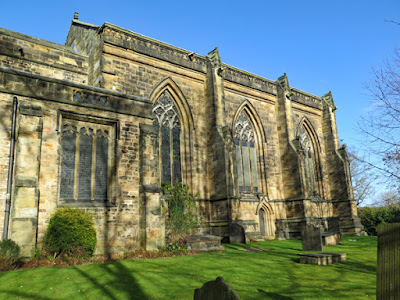After taking a good look at the historic buildings of Dronfield, which I assumed to be built from locally quarried Silkstone Rock, I then wandered down the hill along Church Street to have a look at the Grade I Listed Church of St. John the Baptist.
Usually, when surveying a church for the first time, I walk around its exterior to assess its principal structural form and features and take a few general photos, before looking at the details; however, the extremely bright February sunshine made photography quite difficult and I therefore didn’t closely examine the exterior on this occasion
Compared to most of the mediaeval churches that I had previously seen during my exploration of South Yorkshire and its surrounding counties, its most striking feature is the very large chancel with its very pronounced buttresses – dated 1260 by the official church guide, but which Pevsner attributes to the early C14, based on the style of the tracery in the windows.
Except to the tower, the lack of castellated parapets is also quite noticeable. The roof levels to both aisles were raised in 1855 to accommodate trefoil windows – with a similar detail to the south elevation of the chancel – and the clerestory parapet also appears to be altered. Looking at the size and shape of the blocks of stone used for these parapet details, it is likely that the castellations were removed during this, or a previous phase of Victorian restoration.
While walking further around its exterior, I also noted the disintegrating base and part of the stem of what is considered to be the remains of an Anglo-Saxon cross and a headstone that is made of white marble – with typical saccharoidal weathering.
At the edge of the churchyard, near to the Garden of Remembrance, very many of the headstones are notable for being extremely large and are probably from the quarries at Brincliffe Edge in Sheffield. Here there is also a headstone made by the Commonwealth War Graves Commission (CWGC), which has a carved tiger - the crest of the Royal Leicestershire Regiment.
 |
| A gravestone made in white marble |
At the edge of the churchyard, near to the Garden of Remembrance, very many of the headstones are notable for being extremely large and are probably from the quarries at Brincliffe Edge in Sheffield. Here there is also a headstone made by the Commonwealth War Graves Commission (CWGC), which has a carved tiger - the crest of the Royal Leicestershire Regiment.
 |
| A CWGC headstone |





No comments:
Post a Comment